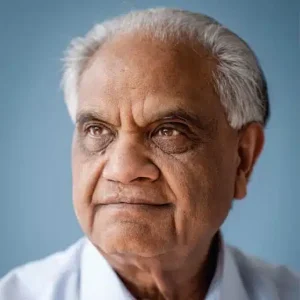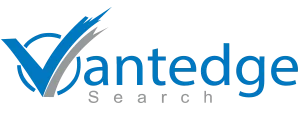- CEOs at the Crossroads of Stability and Transformation
- Expert Corner: Insights from Industry Leaders on Thriving Through Preparation, Perspective, and Purpose
- Executive Movements: Transitions and Pivots
- Career Development Advice: Building Career Resilience in a Transformative Era
View From The Top

Rajesh Khanna,
President,
Vantedge Search
In this edition of The Vantedge Point, we explore how today’s leaders can balance resilience with reinvention. From evolving board dynamics and CEO transitions to career resilience and the future of AI, the pieces in this issue are not just food for thought—they’re a call to action. At Vantedge Search, we remain committed to connecting organizations with leaders who don’t just fit the present but are ready to shape the future. I invite you to dive in, reflect, and imagine what kind of leader you want to be at this turning point—and how you’ll help your organization rise to meet the moment.
CEOs at the Crossroads of Stability and Transformation

2025 marks a decisive moment for business leaders. Economic pressures, geopolitical shifts, and groundbreaking technological advancements are reshaping the essence of how organizations operate. CEOs today face a dual challenge: safeguarding stability while driving transformative change. The stakes are high, and success will depend on the ability to navigate complexity with clarity and precision.
Insights shared by PwC in What’s important to the CEO in 2025 shed light on this dynamic, but the real challenge lies in execution—turning insights into strategic action that balances immediate priorities with long-term opportunities.
Building Stability as a Platform for Growth
In a volatile environment, stability demands a fresh perspective. It means creating a strong operational foundation that can weather external shocks while enabling flexibility for bold moves. CEOs must identify the core strengths that require preservation while rethinking processes or systems that hinder adaptability.
Operational resilience is no longer a passive safeguard—it has become a critical enabler of transformation. When stability is designed with agility in mind, it provides the foundation for strategic reinvention at scale.
The Shift to Exponential Thinking
Generative AI and other emerging technologies are transforming the landscape, requiring organizations to think bigger and act faster. Growth strategies must be built around bold shifts rather than cautious, incremental adjustments. This demands a re-evaluation of business models, focusing on creating new value and entering untapped markets.
To achieve this, CEOs should prioritize:
- Elevating Customer Value: Designing solutions that go beyond meeting needs, addressing new and evolving expectations with precision and foresight.
- Strategic Portfolio Realignment: Making deliberate decisions to invest in growth areas while exiting underperforming markets or business lines.
The organizations that set themselves apart will be those that commit to transformative growth and embed it deeply within their strategy.
Boards Designed for the Future
Boards are evolving into active participants in shaping strategy. Today’s boards must go beyond oversight, offering CEOs actionable insights and future-focused expertise. This shift requires a reassessment of board composition to bring in leaders who can guide organizations through complex technological, sustainability, and geopolitical challenges.
Refreshing the boardroom involves more than replacing individuals. It’s about cultivating a governance structure that challenges assumptions, fosters innovation, and provides the strategic foresight necessary to navigate emerging risks.
Leadership That Combines Agility and Vision
The demands of 2025 require CEOs to balance immediate responses to disruption with a long-term focus on growth and reinvention. Successful leaders are those who can act decisively in times of uncertainty while maintaining a clear trajectory toward the future.
Key priorities for leadership include:
- Workforce Transformation: Fostering a culture of innovation and adaptability, and positioning talent as a critical driver of competitive advantage.
- Proactive Use of Data: Leveraging analytics to anticipate change, seize opportunities, and make well-informed decisions.
- Bold Execution: Taking decisive actions that demonstrate commitment to growth and innovation, while grounding decisions in strategic foresight.
This combination of adaptability and clarity will define the leaders who thrive in the current complex and fast-paced environment.

2025: A Leadership Turning Point
The year ahead represents a significant opportunity for CEOs to demonstrate bold leadership while fostering stability. By using resilience as a platform for transformation, organizations can build systems and strategies that ensure sustainable growth. For executive search professionals, this is the moment to connect companies with leaders who have the vision, courage, and expertise to succeed in an era defined by uncertainty and opportunity.
This is a time for leadership that moves beyond reacting to complexity. It is a moment for action that shapes the future.
For more information on Vantedge Search, please contact us. We look forward to hearing from you.
Expert's Corner –
What's Trending?
Insights from Industry Leaders on Thriving Through Preparation, Perspective, and Purpose
In a world marked by volatility and rapid transformation, today’s most forward-thinking leaders are reimagining how to lead. From strategic foresight in uncertain economies to breakthroughs in AI and evolving roles in corporate governance, leaders like Ram Charan, Fei-Fei Li, and Betsy Atkins share what it truly takes to stay ahead. Their insights spotlight a powerful truth: thriving in disruption isn’t about reacting faster—it’s about preparing smarter, thinking deeper, and leading with clarity of purpose.

Ram Charan, Global Business Advisor, Author and Speaker:
Preparation—A Critical Advantage for Business Leaders
In uncertain times, preparation is the ultimate strategic differentiator for business leaders. As the global landscape evolves rapidly, organizations must shift their focus to anticipating change and acting decisively to stay ahead of rivals.
Strong leadership requires understanding the levers of influence in the current economic and geopolitical climate. With the U.S. economy maintaining relative strength globally, companies operating with foresight and agility have a clear advantage.
2025 will test leaders’ abilities to respond to emerging challenges with clarity and boldness. Those who prepare thoroughly—by strengthening operational resilience, realigning resources, and investing in talent and technology—will be well-positioned to turn disruption into opportunity.
Fei-Fei Li, Stanford AI Visionary:
Spatial Intelligence—Bridging the Gap in AI
Fei-Fei Li emphasizes the critical need for “spatial intelligence” in AI—enabling systems to understand and reason about the 3D physical world. She points out that current generative AI models often fall short, producing “hallucinations” like hands with incorrect fingers. According to Li, this capability is essential to advancing AI’s reasoning abilities and unlocking transformative applications in robotics, AR, and VR.
Through her new venture, World Labs, Li is pioneering “large world models” (LWMs) to bridge this gap. Using synthetic and real-world data, these models aim to go beyond existing architectures like transformers, driving AI toward a future where it can better replicate human understanding of the physical world.

Betsy Atkins, Digital Innovator, Serial Entrepreneur, and Board Veteran: The Transition Challenge—From Leader to Contributor
One of the biggest shifts in modern boardrooms is the integration of Formerly Important People (FIPs)—former CEOs or top executives—into governance roles. While FIPs bring invaluable experience and relationships, their transition from command-and-control leaders to collaborative board members often requires careful coaching.
The role of a board member demands active listening, learning, and concise contributions rather than directive decision-making. FIPs must shift their mindset, moving away from operational involvement to becoming thought partners to the CEO and management. As board members, their success lies in building trust, fostering collaboration, and offering well-timed insights that propel collective decision-making.
For CEOs, the key to maximizing the value of FIPs lies in clear expectations and fostering a board culture where every member’s voice matters. When guided effectively, FIPs can leverage their experience in areas like IPOs, post-merger integration, or crisis management to provide mentorship while supporting management through challenges.
Executive Movements:
Leadership Transitions & Strategic Pivots
CEO Movements
US Bancorp has appointed Gunjan Kedia as its new CEO, effective April 15, marking the first time a woman will lead the bank. Kedia, an industry veteran, will succeed Andy Cecere, who has been with the company for nearly four decades and will remain as executive chairman. Before joining U.S. Bancorp in 2016, Kedia held key roles at State Street, BNY Mellon, McKinsey, and PwC.
Hewlett Packard Enterprise (HPE) has named Maeve Culloty as Executive Vice President, President, and CEO of HPE Financial Services, effective May 1, 2025. She succeeds Gerri Gold, who is retiring after 23 years with the company. Culloty, a senior HPE executive since 2007, brings deep financial expertise and leadership experience, having previously served as Chief of Staff to HPE CEO Antonio Neri. She will oversee HPE’s global financing and asset management business, which plays a key role in the company’s edge-to-cloud strategy and IT lifecycle solutions.
Honda Canada Inc. has announced that Dave Jamieson will succeed Jean Marc Leclerc as President and CEO, effective April 1, 2025. Leclerc, who has dedicated 30 years to Honda Canada, is retiring after a distinguished career that saw him navigate the company through a post-pandemic era. Jamieson, currently Senior VP and COO, brings 30 years of automotive experience and a deep understanding of the North American market.
Global lunar exploration company ispace has announced leadership changes at its U.S. subsidiary, effective April 1, 2025. Former NASA astronaut Ron Garan will step into the role of Chairperson, while Elizabeth Kryst, currently EVP of Programs, will be promoted to CEO of ispace-U.S.
Coursera has announced that Jeff Maggioncalda has retired as President and CEO, with Greg Hart taking over the role on February 3, 2025. Hart, a seasoned leader with over 25 years of experience, previously led Amazon’s Alexa and Prime Video initiatives. Co-Founder Andrew Ng expressed confidence in Hart’s ability to drive Coursera’s next phase of growth.
PepsiCo has appointed Rachel Ferdinando as the new CEO of PepsiCo US Foods, following her tenure as President of PepsiCo Foods Canada. In her new role, Ferdinando will oversee the company’s snack and convenient foods business across the U.S., managing major brands like Lay’s, Doritos, Cheetos, Tostitos, and Quaker Foods.
Walmart Canada has announced Venessa Yates as its new President and CEO. Yates, a seasoned retail leader, has been with Walmart since 2016 and most recently led Walmart+, the company’s membership program. She brings global experience from Walmart, Woolworths, and ALDI. She succeeds Gonzalo Gebara, who is leaving after 25 years with Walmart to return to Argentina.
Blue Bird Corporation has named John Wyskiel as its new President and CEO, effective February 17, 2025. A veteran in the automotive industry with over 35 years of experience, Wyskiel previously led a $6 billion business at Magna International and returns to Blue Bird after two decades. He succeeds Phil Horlock, who will remain on the Board after nearly 15 years as CEO.
Everest Group has appointed Jim Williamson as permanent CEO and President, effective immediately. Williamson, previously EVP and Group COO, steps in following Juan C. Andrade’s departure to lead a financial services firm.
Standard Chartered has appointed Mandy DeFilippo as CEO, US & Americas, effective March 24, 2025. She joins from Citadel Securities and brings extensive financial and risk management expertise.
HanesBrands has announced that CEO Steve Bratspies will step down by the end of 2025 or upon the appointment of his successor. The Board has initiated a comprehensive search, with Bratspies staying in an advisory role to ensure a smooth transition.
Justin Hotard, former head of Intel’s data center and AI group, has been appointed as Nokia’s new CEO, effective April 1. He succeeds Pekka Lundmark, who will step down after four and a half years.
Dan Berce, CEO of GM Financial, will retire in mid-April after a 35-year tenure. Berce, who played a key role in GM’s acquisition of AmeriCredit in 2010, has led the company as president and CEO since its formation.
Michaels has named David Boone, former Staples Canada CEO, as its new chief executive, effective Feb. 28. Boone succeeds Ashley Buchanan, who left in January to lead Kohl’s.
Semrush has named William Wagner as its new CEO, effective March 10, 2025, while Co-Founder Oleg Shchegolev transitions to Chief Technology Officer. The leadership shift aims to accelerate growth by combining Wagner’s SaaS expertise with Shchegolev’s innovation focus.
Gallagher has appointed Sarah Lyons, currently CEO of its Australia and Asia business, as the new CEO of its London-based Specialty division. Her appointment is subject to regulatory approval.
Oppenheimer Holdings has appointed Robert S. Lowenthal as its new CEO and President, effective May 5, 2025. He succeeds Albert G. Lowenthal, who transitions to Executive Chairman after 40 years at the helm.
Unilever announced a leadership shake-up, with CFO Fernando Fernandez replacing CEO Hein Schumacher on March 1. Schumacher, who steps down after less than two years, will leave the company in May.
CFO Movements
- HSBC Names Pam Kaur as CFO – Pam Kaur becomes HSBC’s first female CFO, transitioning from her role as Group CRO and CCO, effective January 1, 2025.
- Schroders Appoints Meagan Burnett as CFO – Meagan Burnett takes over as CFO at Schroders, overseeing finance, tax, treasury, and operations after serving as COO since 2023.
- Societe Generale Taps Leopoldo Alvear as CFO – Former Banco Sabadell CFO Leopoldo Alvear joins Societe Generale as Group CFO, bringing expertise in corporate finance and ECM.
- Morningstar Names Michael Holt as CFO – Michael Holt assumes the role of CFO at Morningstar, leading global finance functions after serving as Chief Strategy Officer for seven years.
- Galaxy Appoints Anthony Paquette as CFO – Anthony Paquette, former Point72 CFO and financial leader at SoFi, joins Galaxy as CFO, effective January 1, 2025.
- Liberty Mutual Names Julie Haase as CFO – Julie Haase, a Liberty Mutual veteran since 2002, steps into the CFO role after serving as EVP and Executive Managing Director.
- Apple Promotes Kevin Parekh to CFO – Apple elevates Kevin Parekh from VP, FP&A to CFO, reporting to Tim Cook and overseeing global finance, treasury, and investor relations.
- Nissan Names Jérémie Papin as CFO – Jérémie Papin takes over as CFO at Nissan, leveraging his deep automotive sector expertise from his years as an equity analyst.
- TD Appoints Michelle Myers as Global Chief Auditor – Former KPMG partner Michelle Myers takes on the Global Chief Auditor role at TD, effective December 9, 2024.
- ANZ Hires Sam Garland as Group GM, Internal Audit – Sam Garland joins ANZ from PwC Australia, bringing 20 years of banking and financial services audit experience.
- NBCUniversal Names Randy Culbertson as CFO – Randy Culbertson has been promoted to CFO at NBCUniversal, where he will oversee finance and strategy across all divisions.
- Freddie Mac Appoints James Whitlinger as CFO – James Whitlinger steps in as Freddie Mac’s new CFO, bringing over a decade of financial leadership within the company.
- Coca-Cola Consolidated Taps Matthew Blickley as CFO – Matthew Blickley has been named CFO of Coca-Cola Consolidated, continuing his role as the company’s chief accounting officer.
- Lucid Names Taoufiq Boussaid as CFO – EV maker Lucid appoints Taoufiq Boussaid as CFO, tasking him with aligning financial strategy to drive growth and shareholder value.
- Medtronic Hires Thierry Pieton as CFO – Medtronic brings in Thierry Pieton from Renault as CFO, leveraging his experience in driving record operating margins and cash flow.
- IBC Advanced Alloys Appoints Terena White as CFO – IBC names Terena White as CFO, promoting her from Corporate Controller as she succeeds the retiring Toni Wendel.
- Forge Global Appoints James Nevin as CFO – Former London Stock Exchange executive James Nevin joins Forge Global as CFO, bringing 25+ years of financial and capital markets expertise.
CIO/CTO Movements
- Boeing appoints Dana Deasy as CIO, leveraging his Pentagon experience to drive IT and data analytics innovation.
- Greg Barbaccia is named Federal CIO, overseeing U.S. government IT policy, spending, and cybersecurity initiatives.
- Evan Wayne joins Marcus & Millichap as CIO, leading tech-driven solutions for investment sales and advisory services.
- Brad Novak becomes DXC Technology‘s CIO, focusing on AI integration within global IT operations.
- Elliott Cheu is appointed interim CIO at the University of Arizona, balancing academia and physics research at CERN.
- Dan Cronin takes on the role of Oklahoma’s CIO, bringing experience from Marriott, Allstate, and the automotive tech sector.
- Christian Theumer is promoted to CIO of Purdue University, overseeing IT services and cybersecurity strategies.
- Josh Jones is named CIO of Nice North America, leading IT integration across home automation brands.
- Sandy Venugopal becomes CIO of CoreWeave, driving AI and digital transformation for the hyperscaler company.
- Nick Nadgauda is appointed MetLife’s EVP & CIO, leading enterprise technology innovation for customer-centric solutions.
- Justin Mennen joins Shake Shack as CIO, spearheading IT strategy and tech-driven business operations.
Insights: Inferring the why
The latest wave of CEO transitions reflects broader shifts in corporate priorities across industries. From financial services to retail and technology, companies are making strategic leadership decisions in response to economic uncertainty, digital transformation, and competitive pressures. These changes underscore critical themes in corporate governance, operational focus, and leadership philosophy. Here’s what these movements reveal about the evolving business landscape.
- Operational Efficiency Takes Center Stage
Companies are favoring leaders with strong execution skills rather than those with purely visionary ambitions. The appointment of leaders like Fernando Fernandez at Unilever and David Boone at Michaels signals a desire for CEOs who can rapidly implement strategic initiatives rather than overhaul them. This shift highlights the increasing pressure on executives to deliver measurable performance improvements in shorter timeframes.
- The Rise of CFOs as CEOs
The elevation of finance executives indicates a growing preference for CEOs with financial acumen. As businesses navigate volatile economic conditions, boards are turning to leaders who can optimize margins, manage costs, and sustain profitability. This trend underscores the critical role of financial expertise in corporate strategy, particularly in industries where economic fluctuations heavily impact operations.
- Navigating Industry-Specific Disruptions
Many of the recent CEO appointments align with sector-specific challenges. For example, Justin Hotard’s move to Nokia highlights the increasing convergence of AI and telecommunications, while Elizabeth Kryst’s promotion at ispace reflects the intensifying competition in the private space sector. Similarly, the leadership change at Everest Group signals an emphasis on navigating evolving risks in global insurance and reinsurance. These shifts indicate that industry expertise is more valuable than ever in guiding companies through market disruptions.
- Leadership Continuity as a Competitive Edge
Several companies have opted for structured successions rather than abrupt leadership changes. Oppenheimer Holdings and HanesBrands have ensured smooth transitions by keeping outgoing CEOs in advisory roles. This structured approach helps maintain investor confidence and operational stability, reducing the risks associated with sudden leadership shifts.
- Female Leadership Gains Traction—But Slowly
The appointments of Gunjan Kedia at US Bancorp, Maeve Culloty at HPE Financial Services, and Venessa Yates at Walmart Canada represent steps toward gender diversity in executive leadership. However, these remain isolated examples rather than a widespread trend. While progress is evident, the slow pace of change suggests that organizations still have significant work to do in building more inclusive leadership pipelines.
- Tech-Driven CEOs for a Digital Future
Companies are prioritizing leaders with technology and digital transformation experience. Greg Hart’s appointment at Coursera, William Wagner’s move to Semrush, and Nokia’s recruitment of Justin Hotard reflect the need for executives who understand AI, data analytics, and digital ecosystems. This trend highlights the growing expectation that CEOs must not only oversee business strategy but also drive technological innovation.
Conclusion
The latest CEO appointments illustrate a decisive shift in corporate priorities. Companies are focusing on execution, financial discipline, industry expertise, and digital transformation as they navigate an increasingly complex business environment. While leadership diversity is progressing, it remains an area that requires more systemic change. As businesses continue adapting to economic and technological shifts, the role of the CEO is evolving—placing a premium on strategic agility, operational efficiency, and long-term stability.
Building Career Resilience in a Transformative Era
As industries continue to evolve at an unprecedented pace, career resilience is emerging as a key differentiator for professionals seeking long-term success. To future-proof their careers, individuals must cultivate adaptability and embrace continuous learning as foundational principles. The ability to pivot, acquire new skills, and respond proactively to change is crucial for staying relevant in today’s dynamic environment.
Continuous learning lies at the heart of career resilience. Professionals should actively seek opportunities to expand their skill sets through executive education programs, certifications, and targeted training in emerging technologies like AI, data analytics, and digital transformation. Embracing online learning platforms such as Coursera, edX, or LinkedIn Learning enables individuals to access a wide array of courses that can sharpen their expertise and prepare them for new challenges. Additionally, enrolling in specialized programs or workshops can provide in-depth knowledge on critical topics, offering a competitive edge in a rapidly changing job market.
Another critical component of building resilience is networking across diverse sectors. A broad and varied network serves as a resource for gaining insights, identifying new opportunities, and fostering collaboration. By connecting with professionals from different industries, individuals can gain exposure to a range of perspectives and emerging trends, making them more adaptable to shifts in the market. Networking can be facilitated through industry events, webinars, and professional organizations, but it’s equally important to leverage social platforms like LinkedIn for maintaining and nurturing these connections over time.
Personal branding is essential for standing out in a crowded field. In an era where digital presence influences professional visibility, individuals should strategically use platforms like LinkedIn to share thought leadership, industry insights, and accomplishments. Writing articles, participating in relevant discussions, and speaking at webinars or conferences are effective ways to position oneself as an expert in a specific area. A strong personal brand not only amplifies one’s professional credibility but also attracts opportunities for collaboration, mentorship, and career advancement.
Building career resilience also involves adapting to new workplace dynamics. With remote and hybrid work models becoming the norm, professionals must develop competencies in virtual communication, digital collaboration tools, and project management. Staying adaptable to various work environments enhances one’s ability to thrive regardless of changes in workplace settings.
Lastly, mentorship and reverse mentorship can play a pivotal role in career resilience. Seeking mentors who can provide guidance on navigating career shifts, as well as engaging in reverse mentorship to understand the perspectives of younger professionals, ensures that individuals stay informed and connected with evolving trends. This exchange of insights fosters growth and adaptability, equipping professionals with the tools to tackle challenges as they arise.
Ultimately, building career resilience is an ongoing process that requires intentional efforts in learning, networking, and self-presentation. By embracing these strategies, professionals can not only safeguard their careers against industry disruptions but also position themselves for sustainable success in a rapidly transforming world.


